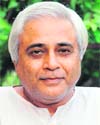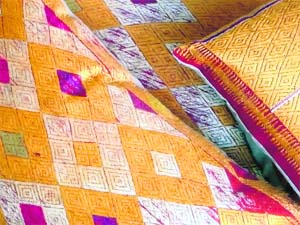|
punjabi
antenna
Tradition,
culture, phulkari
Randeep
Wadehra  WHY would anyone
settle here?" asked the bemused anchor of DD Jalandhar’s
episodic show Aaja mera pind dekh ja, which features
different villages of Punjab. He was talking of Lehroon — a
village in Gurdaspur district that lies on the state’s border
with Himachal Pradesh. Till a bridge was constructed a couple of
years ago, the villagers generally remained cut off from the
rest of the world. In order to go to other villages, the people
had to cross a choe, which claimed many lives annually,
including that of the village sarpanch and a bridegroom.
But things are
better now. The bridge has brought several modern amenities to
the place — a dispensary, private and government schools,
electricity etc. Strikingly, men from every house here are
either in the Indian Army or the paramilitary forces. Although
proud of their achievements, the villagers point out that not a
single person has ever been employed in the state’s civil
services — "not even as a chaprasi." They
feel aggrieved on this count.
Although the term phulkari
literally means flower work or flower craft, this traditional
form of embroidery displays prominently other rural motifs, too
— wheat and barley, stem and ear. On June 21,DD Jalandhar
telecast a documentary on phulkari in its Virasat slot.
There were young women in shawls and odhnis — the
richly embroidered head-scarves — decked up in the best of
traditional finery meant for wedding-related celebrations. They
performed giddhaas and tappaas, too.
|

According to scholars, the craft of phulkari came from Central Asia when tribes from there migrated to the subcontinent
|
Although the
accompanying commentary dwelt upon phulkari’s close
association with Punjabi culture, rituals and traditions, many
details were left out; or, perhaps, they escaped my attention.
For example, several experts claim that phulkari has roots in
Iran’s gulkari art of embroidery, which has flowery
motifs. According to several scholars and folklorists, this
craft came from Central Asia when tribes from there migrated to
the subcontinent. Consequently, Pakistani Punjab’s northern
regions of Hazara and Chakwal boast of some of the best phulkari
designs and products. Moreover, phulkari embroidery is generally
sparse. Its richer version — used on garments that cover the
entire body — is called bagh, or garden, wherein the
embroidery covers the entire fabric. Originally, phulkari used
to be done by hand on khaddar fabric with silk thread; shades of
red and gold predominated, while black and blue were avoided.
Today it is done
by machines on other fabrics, too, and the thread may not
necessarily be silk.
Talking of women
in the region, Haryana Speaks on PTC News compared
the socio-economic conditions of Haryanvi women with that of
their sisters in Punjab — to the former’s disadvantage.
Several reasons were trotted out like Haryana’s belated
economic progress, prevalence of medieval customs and practices
that tend to keep women in Haryana educationally backward and
economically dependent on their men-folk. However, there is the
upside, too. Women in Haryana are firmly on the path to
emancipation despite the rather violent backlash from the
society’s patriarchs epitomised by the Khaap Panchayats.
Nonetheless, an
absorbing debate wherein Randip Surjewala’s well thought out
and reasoned comments proved to be the show’s highlight.
|